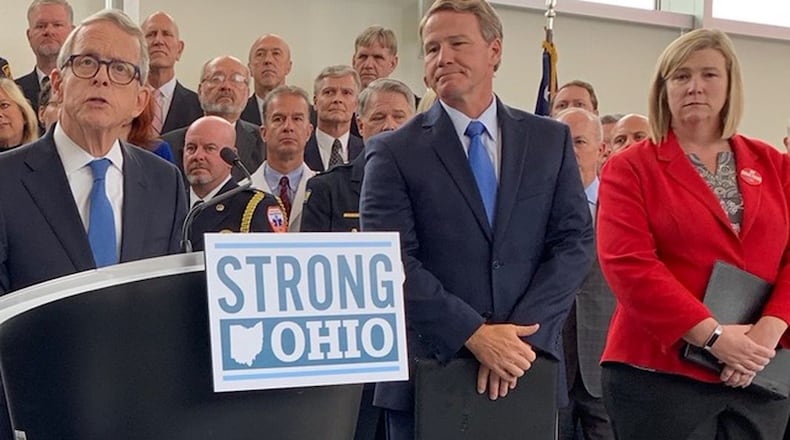In the Democratic race they handily defeated former Cincinnati Mayor John Cranley, whose running mate was state Sen. Teresa Fedor.
On the Republican side, three of the four tickets were all-male, including DeWine’s, who retains Lt. Gov. Jon Husted as his running mate.
Fourth-place finisher Ron Hood’s running mate was former state Rep. Candice Keller.
“Certainly her candidacy is historic, and I think it’s a sign of the changes within the Democratic Party where it’s unlikely to see all white male tickets in national or state races,” said Lee Hannah, associate professor of political science at Wright State University. “I think Whaley will have her eye on urban and suburban voters as a high priority, but the Democrats also have to start running stronger in rural counties, too; and I’m sure their team is trying to think about how they craft an economic message for these areas.”
If she wins, however, Whaley wouldn’t be the first woman to hold the post. Nancy Hollister, a Republican, served as governor for 11 days at the beginning of 1999.
Hollister, who replaced DeWine as lieutenant governor in 1994 when he was elected to the U.S. Senate, became governor after George Voinovich’s election to the Senate as well. She filled out the last days of Voinovich’s term until then newly elected Gov. Bob Taft took office.
Whaley won the Democratic primary by a wide margin, but she didn’t come close to DeWine’s vote total. Just over 1 million Republicans voted in the primary vs. half a million Democrats.
DeWine earned almost half the vote in a four-way race, noted Mark Caleb Smith, director of the Center for Political Studies at Cedarville University.
“Whaley needed DeWine to lose, or she needs the national and state climate to turn toward the Democratic Party,” he said. “She will have a hard time unseating someone with DeWine’s deep roots in the state.”
Primary turnout isn’t necessarily reflective of how the November general election will go, Hannah said. An influx of money and visits from high-profile national figures stirred Republican interest in the U.S. Senate race, driving voter mobilization that likely spilled over into the gubernatorial primary, he said. Even so, it will be an uphill battle for Whaley.
“At the moment, the Republican Party seems to have a pretty large advantage in Ohio. Even in 2018, when all indicators pointed to a ‘Blue Wave,’ Ohio went against the trends,” Hannah said. “Now, in a midterm election with a Democrat in the White House, the Republicans should be poised to maintain control in the fall.”
But a lot of things could change that before November, he said.
A big factor in the fall election may be the potential overturn of Roe v. Wade. A leaked draft opinion from the U.S. Supreme Court indicates that the 1973 decision legalizing abortion may soon be reversed.
On election night, Whaley predicted that if Roe is overturned, DeWine would oversee criminalization of abortion in Ohio.
“It will be interesting to see how much she incorporates a potential reversal of Roe into her campaign,” Smith said. “Since abortion may truly become a statewide political issue, she has an opportunity to take advantage of a combustible matter.”
In 2019 DeWine signed a “Heartbeat Bill,” which would ban almost all abortions after six weeks — before many women know they’re pregnant — as Texas has passed and other Republican-run states are considering. Its implementation has been blocked in court, but DeWine has signaled interest in reviving it if Roe falls.
“This could become a major fault line in the fall,” Hannah said. “The pro-life movement has been galvanized because abortion is legal — if it is overturned, we might see a similar galvanizing effect on the pro-choice movement.”
It’s an issue that may reinforce the urban-rural divide in Ohio voters, he said. A Pew Research poll found 61% of urban voters and 59% of suburban voters support abortion rights, compared to 46% of rural voters, Hannah said.
About the Author

